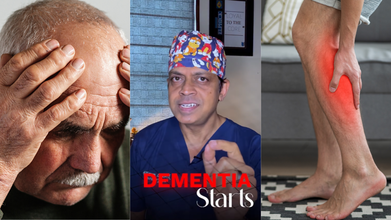- Health Conditions A-Z
- Health & Wellness
- Nutrition
- Fitness
- Health News
- Ayurveda
- Videos
- Medicine A-Z
- Parenting
- Web Stories
Biological Age vs. Chronological Age: Signs Your Body Is Aging Prematurely

Why your body’s real age might be older or younger than the number on your birthday cake. Aging is a natural part of life, but what if your body is aging faster than it should? While your birth date gives you a chronological age, your biological age tells a more nuanced, and often more accurate, story about how well or poorly your body is holding up. In recent years, scientists have emphasized the significance of biological age as a powerful indicator of health risks, longevity, and overall physiological decline.
Chronological age is simple it’s the number of years you’ve been alive. Biological age, on the other hand, measures how your body functions on a cellular and molecular level. It considers markers like DNA methylation, telomere length, and inflammation, offering a clearer picture of your physical health.
For example, someone may be 45 years old chronologically but have a biological age closer to 55 due to poor lifestyle choices, chronic stress, or disease. Conversely, a person in their 60s who leads a healthy life might have the biological age of someone in their 40s.
Emerging research confirms that biological age is a stronger predictor of mortality and disease than chronological age, especially in critically ill patients. This insight is shifting the healthcare paradigm toward personalized, preventative strategies that focus on biological aging.
Role of Biomarkers in Biological Aging
To determine biological age, researchers assess various biomarkers, each offering a snapshot of different aspects of aging.
Telomere Length: Telomeres are protective caps at the ends of chromosomes. They shorten each time a cell divides, and when they become critically short, cells either stop functioning or die. Accelerated telomere shortening is linked with premature aging and age-related diseases.
Epigenetic Clocks: These tools, including DNAmAge, Hannum, PhenoAge, and GrimAge, measure changes in DNA methylation—chemical modifications that influence gene expression. PhenoAge and GrimAge, in particular, closely correlate with telomere length and can predict disease onset and lifespan with remarkable accuracy.
Inflammation Markers: Chronic low-grade inflammation, also known as “inflammaging,” is a key driver of age-related disorders. Blood levels of C-reactive protein (CRP) and various cytokines can reveal how inflamed—and therefore how aged—the body really is.
These biomarkers collectively help gauge the true biological toll life has taken on the body, far beyond what a birth certificate can tell you.
Health Risks of Premature Biological Aging
Biological age has real-world health consequences. Individuals whose biological age outpaces their chronological age are at higher risk for chronic diseases, including cardiovascular conditions, cancer, and neurodegenerative disorders.
Heart Disease and Cancer: Aging naturally compromises the cardiovascular system. But accelerated aging, especially in the presence of risk factors like obesity, diabetes, or hypertension, hastens this decline. Likewise, age-related changes such as inflammation, mitochondrial dysfunction, and cellular senescence create fertile ground for cancer development.
Cancer Survivors and Cardiovascular Risks: Cancer therapies, particularly in older adults, may further accelerate biological aging. Studies show that survivors over age 65 face increased cardiovascular risks, often surpassing cancer as the leading cause of death in this group.
Signs to Watch For You Aging Faster Than You Should
While diagnostic tools can assess biological age in a clinical setting, your body often sends early warning signals of premature aging. If you’re noticing these signs, it may be time to reassess your health habits.
1. Sun-Damaged Skin
Excessive UV exposure breaks down collagen and elastin, leading to sagging skin, fine lines, and pigmentation issues. Skin that appears leathery, paper-thin, or mottled may signal underlying cellular damage.
2. Stiff Joints
Unexplained joint pain or reduced flexibility in your 30s or 40s can reflect early cartilage wear—an age-related phenomenon that may be sped up by sedentary habits or inflammation.
3. Early Hearing Loss
Hearing changes are expected with age, but if you're experiencing diminished hearing sensitivity before age 60, noise-induced damage from headphones, loud environments, or machinery could be aging your auditory system prematurely.
4. Accelerated Hair Loss
While graying and thinning are normal, sudden shedding—especially after stress—may be linked to hormone shifts or inflammatory processes that mimic aging.
5. Weak Immune Function
If you frequently catch infections or struggle to recover, your immune system might be aging faster than it should. Chronic stress and poor nutrition can accelerate immune aging, raising susceptibility to disease.
6. Cognitive Fog and Memory Lapses
Occasional forgetfulness is normal, but persistent memory problems or reduced focus in midlife may be signs of neurobiological aging driven by poor sleep, stress, or lack of mental stimulation.
7. Bruising Easily
Thinning skin and fragile capillaries increase bruising with age, but if it’s happening too frequently—or suddenly—it might reflect premature structural breakdown of connective tissues.
8. Irregular Menstrual Cycles
Hormonal shifts that occur in perimenopause usually start in the 40s. But if you’re seeing major menstrual changes in your 30s, early menopause or ovarian aging could be to blame.
Can You Reverse or Slow Down Biological Aging?
The good news: biological age is modifiable. Interventions that reduce oxidative stress, improve metabolic health, and lower inflammation can reverse certain signs of accelerated aging.
Nutrition: Diets high in fresh produce, lean protein, and healthy fats combat inflammation and support cellular health. Reducing sugar and refined carbohydrates may also protect your skin and brain.
Exercise: Regular physical activity boosts cardiovascular health, builds muscle mass, and slows telomere shortening.
Sleep and Stress Management: Prioritizing deep, restful sleep and adopting stress-relief techniques like mindfulness and therapy can positively impact your biological age.
Preventive Healthcare: Getting regular screenings and addressing metabolic conditions early on helps keep your biological age aligned with or younger than your chronological one.
Why Do I Get Bad Dreams When I Am Sick?

Credits: Canva
What's worse than running nose, continuous sneezing, and a fever? It is the dreams you get when you have finally managed to put yourself to sleep, and those dreams are bad, scary, intense, and negative. Why does this happen?
What Is A Fever Dream?
A dream is basically a series of thoughts, images, sensations that you feel while you are sleeping, and scientists tell us that we have our strongest dreams during the rapid eye movement or the REM of the sleep stage.
Certain factors, including you health could influence your sleep visions and your dreams. A change in body temperature, especially when it is higher than usual could lead to a fever dream, which mostly could be intense, like a nightmare.
As per a 2016 study published in the International Journal of Dream Research, 94 per cent of participants described their fever dreams as negative. Another 2013 study noted that one of the participants had dreams that would move "back and forth between a very difficult circumstance and a very comfortable circumstance." A recent online study in 2020, published in the journal Frontiers Psychology noted that of the 164 participants, 100 of them reported fever dreams. Most of them said that fever dreams were more bizarre, and negatively toned.
While fever dream is known in the medical literature, the scientific studies on the same are limited. Many often describe this as an emotionally intense, troubling, strange, out of character, or a scary dream. The dreams could be the result of less social interactions due to someone being sick.
When Does A Fever Dream Happen?
A fever dream happens when the normal body temperature rises 2 degrees above. The normal body temperature is between 97 and 99 degree F. Anyone can develop a fever, due to the following conditions:
- a viral or bacterial infection
- heat exhaustion
- certain inflammatory conditions such as rheumatoid arthritis
- medicines, such as antibiotics
- an immunization
- a tumor
Why Do You Get Bad Dreams During Fever?
While there is no exact reasoning for it, the 2020 online study notes that the concept behind this is the 'over-heated' brain. High temperature of the body could disrupt the brain's normal cognitive functions. The authors of the 2020 study note, "The basic idea is that the ‘over-heated’ brain is not functioning properly and, therefore, dreams are more bizarre.”
During the REM stage of sleep, the phase where your most vivid dreams unfold, the body already struggles to regulate its internal temperature. When a fever strikes, it disrupts this delicate balance even further, often resulting in intense or disturbing dreams. Fevers can also stir the mind in other unsettling ways, sometimes causing waking hallucinations, irritability, or even brief episodes of confusion.
Dr Mark Rosenblum, who is a sleep psychologist with Hennepin Healthcare, tells CBS News that the reason behind intense dream during sickness is due to REM. He says, "If someone's not getting enough sleep, they get what's called REM rebound on the following nights. And when we have REM rebound, what we'll find is all our dreams tend to be very intense."
Are There Any Symptoms Of Fever Dreams?
As per a 2016 study published in the International Journal of Dream, fever dreams contain some sort of spatial distortion, that include:
- Moving walls
- Creatures with oversized arms and legs
- Metal spheres that move like an organism
- Blackness spreading slowly
- Gigantic insects
Dementia Starts In Your Legs, According To Doctor; What Are The Signs And Tips To Prevent It?

Credits: Instagram and Canva
Bengaluru based neurosurgeon Dr Arun L Naik dropped a video on his Instagram account @doclogues, which has shocked the world, because he says that 'Dementia Starts in Your Legs'.
As of now, most of us knew that it is a general term for a loss of thinking, and is part of normal aging and related to brain diseases that damage the nerve cell. However, Dr Naik notes that as per a 2020 study, it was found that those who walk in a slow speed, especially older adults, were more likely to face the risk of cognitive decline. "Why?" To this, Dr Naik writes that walking is not just a physical task, "it is a full brain workout".
How Is Walking Related To Brain Health? Can Lack Of It Cause Dementia?
Dr Naik writes that there exists a brain-leg connection. "Every step involves coordination between the frontal lobe, cerebellum, spinal cord, and proprioceptive feedback loops."
The second point he notes is of the circulation boost. He writes that leg movement improves blood flow to the brain, and it delivers oxygen, glucose, and clears out toxins.
Then comes gait changes, which the doctor says must be considered as brain warning. It is brain's way to tell that changes in walking style, balance, or pace could proceed to memory symptoms by years.
Lastly, he notes is the neuroplasticity in motion. He says that walking stimulates the brain-derived neurotrophic factor, which strengthens neuron connections. This is why, "weak legs can speed up cognitive decline," he says in his video.
What Study Is The Doctor Quoting When He Says That Dementia Starts From Leg?
The study is a 2020 review, which was published in the Journal of Aging Research. This is where it was seen that older adults, who stay physically active are less likely to develop cognitive decline or dementia. The study analyzed over 1,60,000 people and found that regular exercise reduced the risk of dementia by 28 per cent and Alzheimer's disease by 45 per cent.
With aging, especially from mid-50s, most adults begin to lose 1 to 2 per cent of muscle mass every year, this process is further accelerated by inactivity. This loss then not only affects mobility, but also metabolism and blood circulation, which results in less oxygen reaching to your brain, as the doctor also explained.
This is why the doctor says, "if your legs slow down, your brain may follow".
Can Something Be Done To Prevent Dementia?
The answer is yes. Dr Naik also says, "studies have shown that it is never too late to start. Starting even in your 60s can reduce dementia risk by a mile". So, what is he asking people to start? He is urging people to start some activity, to help their bodies move, and enable the brain to leg coordination.
The doctor also notes some "strategies" to prevent dementia in the caption of his post through movements, which are as followed:
- Walk 30 minutes daily at a brisk pace.
- Add balance exercises like tandem walking and single-leg stands.
- Practice dual-task walking (e.g. walking while talking or solving a simple mental task).
- Include strength training for lower limbs—muscle is cognitive insurance.
- Avoid long periods of sitting—movement every hour keeps memory sharp.
Fact Check: Does Cracking Your Knuckles Every Day Damage Your Joints?

Credits: Canva
If you are someone who cracks your knuckles every day just for that oddly satisfying pop, you are not alone. For many, the sharp sound brings a fleeting sense of relief or relaxation. Yet, there has long been a debate about whether this seemingly harmless habit could actually damage your joints or raise the risk of arthritis.
For those unversed, the pop you hear when cracking your knuckles comes from gas bubbles in the joint fluid collapsing. For most people, it’s harmless, though it can occasionally cause slight swelling or a temporary drop in grip strength. The long-standing belief that it leads to arthritis is not backed by science, but using too much force could result in minor injuries, like ligament sprains or dislocations
Addressing this common worry, orthopedic surgeon Dr. Manan Vora answered the question in a viral reel that has now surpassed 2.5 million views. A viewer asked him, “Can cracking knuckles every day lead to arthritis?”
Dr. Vora said, “The pop you hear when cracking a knuckle is the sound of these bubbles bursting within the synovial fluid inside the joint,” he clarified.
Is Cracking Knuckles Bad For You?
Knuckle cracking is a habit many pick up early in life, often because they enjoy the sound or the temporary feeling of looseness in the fingers. According to the Johns Hopkins Arthritis Center, the sound comes from changes inside the joint capsule, which is filled with synovial fluid. This fluid not only lubricates the joints but also nourishes the surrounding bones.
“A variety of gases are dissolved in this fluid. When a knuckle is cracked, stretching the capsule lowers the pressure inside, creating a vacuum. The dissolved gases form a bubble, which bursts, producing the familiar popping sound. It takes time for the gases to re-dissolve, which is why you can’t immediately crack the same knuckle again,” Johns Hopkins adds.
Does Cracking Knuckles Cause Arthritis?
Many worry that frequent knuckle cracking could trigger arthritis. However, research shows there is no evidence linking the habit to arthritis or long-term joint damage. A few reports have noted that excessive cracking may occasionally cause minor ligament strains or tendon dislocations, but these injuries typically heal on their own.
Some studies also suggest that habitual knuckle crackers might have slightly reduced grip strength over time, but this does not equate to arthritis. Rarely, “knuckle pads” can develop in young people who crack their knuckles often, but these are mostly cosmetic.
Several studies back up the conclusion that knuckle cracking does not cause arthritis. For example, a study by the Uniformed Services University of the Health Sciences followed 215 participants, 20% of whom regularly cracked their knuckles. They found arthritis in 18.1% of knuckle crackers and 21.5% of non-crackers, essentially the same rate, showing no link between the habit and the disease.
A famous anecdote comes from Dr. Donald Unger, who cracked the knuckles on his left hand twice daily for 50 years while leaving his right hand untouched. Published in Arthritis and Rheumatism in 1998, the informal experiment revealed that neither hand showed signs of arthritis. More recent studies in 2017 reached similar results, finding no difference in hand function between people who cracked their knuckles and those who didn’t.
What Is Arthritis?
Arthritis is a condition that causes inflammation and pain in one or more joints, often leading to stiffness and limiting the joint’s range of motion. Genetics play a major role, with environmental triggers contributing to inflammatory types, and age or mechanical stress driving degenerative arthritis.
Other risk factors include obesity, previous joint injuries, family history, older age, and being female. But as research confirms, knuckle cracking is not one of them.
© 2024 Bennett, Coleman & Company Limited

